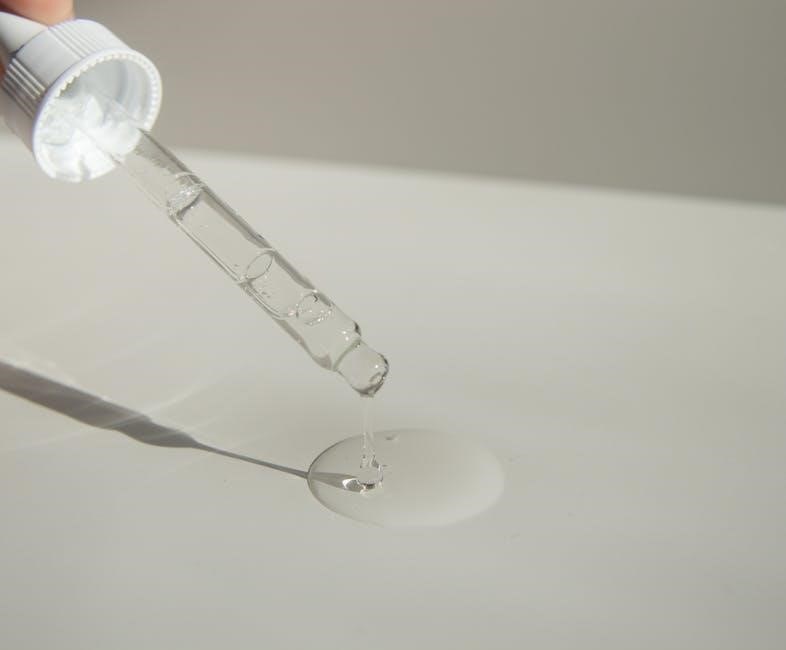
Essential oils are concentrated plant extracts known for their aromatic and therapeutic benefits‚ offering natural solutions for wellness‚ relaxation‚ and health through centuries of traditional use.
What Are Essential Oils?
Essential oils are highly concentrated‚ aromatic compounds extracted from plants‚ capturing their unique scents and therapeutic properties. Derived from flowers‚ leaves‚ roots‚ and other plant parts‚ these oils are obtained through methods like steam distillation or cold pressing. They are natural‚ potent‚ and often used in aromatherapy‚ skincare‚ and wellness practices to promote physical and emotional well-being. Essential oils are valued for their versatility and ability to enhance health and mood naturally.
Historical Roots and Natural Plant Origins
Essential oils have ancient origins‚ dating back thousands of years to early civilizations in Egypt‚ China‚ and Greece. These cultures utilized aromatic plants for rituals‚ healing‚ and perfumery. Extracted from various plant parts‚ essential oils were valued for their medicinal and spiritual properties. Their natural origins and historical use highlight their significance in traditional medicine and holistic practices‚ forming the foundation of modern aromatherapy and wellness traditions.
Essential Oils vs. Aromatic Compounds
Essential oils are pure‚ concentrated plant extracts‚ while aromatic compounds are synthetic or natural substances mimicking scents. Essential oils retain the plant’s therapeutic benefits‚ offering holistic health advantages. Aromatic compounds‚ often used in perfumes‚ lack the same potency and natural therapeutic properties‚ making them distinct from genuine essential oils in both composition and application.
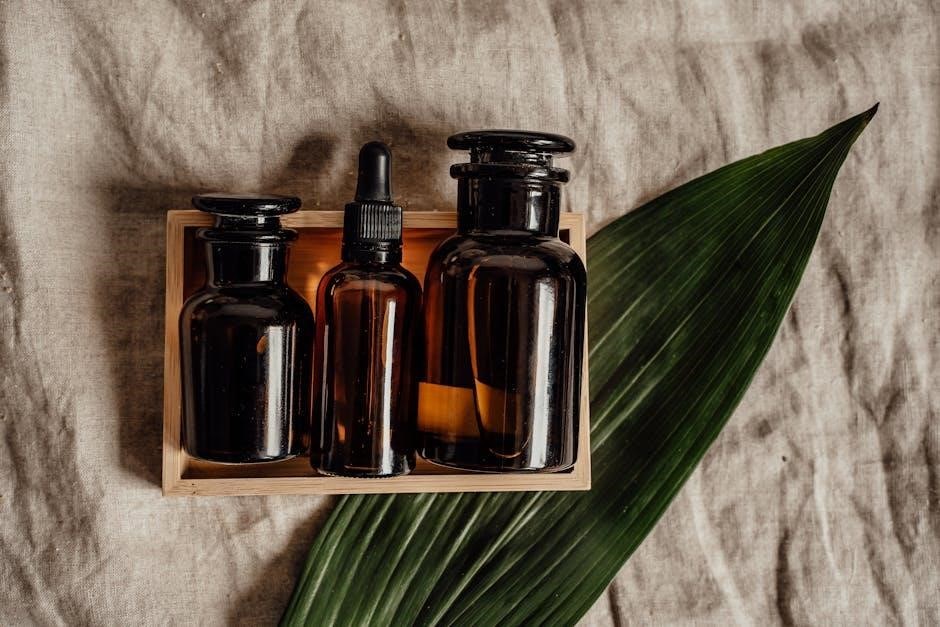
Popular Types of Essential Oils
Lavender oil‚ tea tree oil‚ and frankincense are among the most popular essential oils‚ each offering unique benefits for relaxation‚ skin care‚ and overall wellness.
Lavender Oil: Benefits and Uses
Lavender oil is renowned for its calming and soothing properties‚ promoting relaxation and improving sleep quality. It is widely used in aromatherapy to reduce stress and anxiety. Known for its gentle nature‚ lavender oil is beneficial for skin health‚ treating acne‚ and soothing burns or cuts. It can be applied topically when diluted with a carrier oil or inhaled through diffusion. Lavender oil also pairs well with other oils like chamomile for enhanced effects. Always ensure proper dilution and safe usage for optimal benefits.
Tea Tree Oil: Versatility in Cleaning and Health
Tea tree oil is a versatile essential oil with antimicrobial properties‚ making it ideal for both health and cleaning. It is widely used to treat acne‚ fungal infections‚ and minor wounds due to its germ-fighting abilities. In cleaning‚ it is effective against bacteria and mold‚ making it a popular choice for eco-friendly cleaning products. Diluted tea tree oil can be applied topically for skin issues or added to natural cleaning solutions for a fresh‚ chemical-free alternative. Its strong scent also repels insects‚ adding to its practical uses.
Frankincense Oil: Ancient Uses and Modern Benefits
Frankincense oil‚ derived from the resin of the Boswellia tree‚ has been used for centuries in traditional medicine and spiritual practices. Known for its anti-inflammatory and antiseptic properties‚ it is often used to reduce pain‚ improve skin health‚ and promote relaxation. Modern applications include aromatherapy for stress relief and natural remedies for joint pain. Frankincense oil is also valued for its ability to enhance focus and reduce anxiety‚ making it a versatile addition to both health and wellness routines.
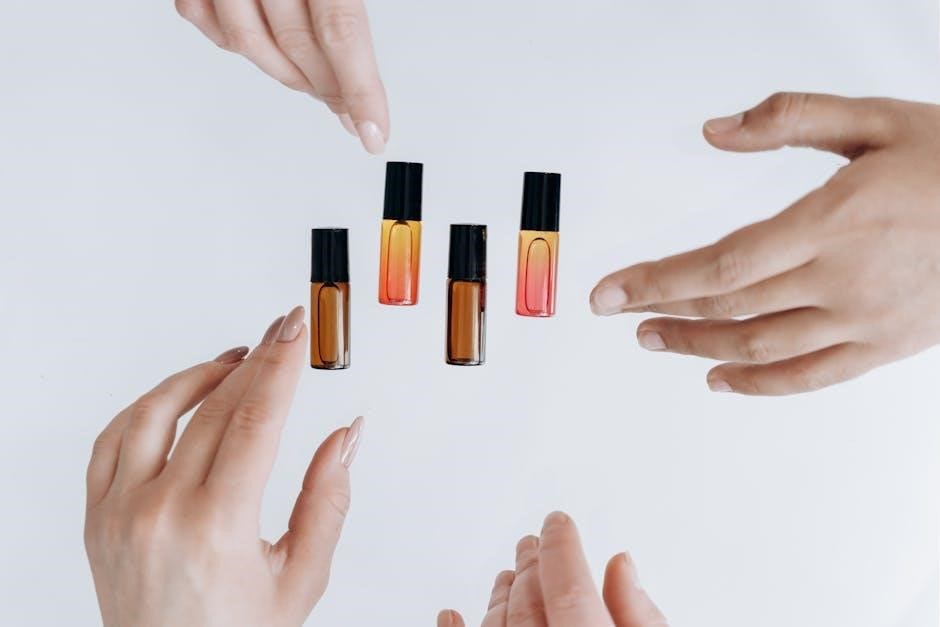
Benefits of Essential Oils
Essential oils promote relaxation‚ reduce stress‚ alleviate pain‚ and enhance skin health‚ offering natural solutions for emotional and physical well-being through their aromatic and therapeutic properties.
Relaxation and Stress Relief
Essential oils are renowned for their calming effects‚ offering natural solutions for relaxation and stress relief. Lavender oil‚ with its soothing properties‚ helps reduce anxiety and promotes peaceful sleep. Chamomile oil calms the mind and body‚ while bergamot oil uplifts the spirit‚ easing stress. Frankincense and sandalwood oils also provide grounding effects‚ enhancing mental clarity. These oils can be used in diffusion‚ topical application‚ or inhalation‚ creating a serene atmosphere and balancing emotional well-being. Regular use encourages mindfulness and tranquility‚ making them ideal for daily stress management.
Pain Relief and Inflammation Reduction
Essential oils offer natural solutions for pain relief and inflammation reduction. Wintergreen oil‚ containing methyl salicylate‚ acts as a topical analgesic‚ while peppermint oil’s menthol cools sore muscles. Eucalyptus oil reduces inflammation and eases joint pain. Frankincense oil has anti-inflammatory compounds‚ and ginger oil provides warming relief for muscle tension. These oils can be applied topically with carrier oils or inhaled for systemic benefits. Always dilute appropriately and consult a healthcare professional before use‚ especially for chronic conditions‚ to ensure safe and effective relief;
Skin Health and Beauty Applications
Essential oils are widely used in skincare for their natural‚ therapeutic properties. Lavender oil soothes acne and promotes healing‚ while tea tree oil’s antimicrobial properties combat breakouts. Frankincense oil reduces inflammation and prevents premature aging. Geranium oil balances skin pH‚ minimizing oil production. These oils can be incorporated into facial serums‚ moisturizers‚ or masks. Always dilute with carrier oils like jojoba or almond oil before application. Patch testing is recommended to ensure compatibility and avoid allergic reactions‚ ensuring safe and effective skincare routines.
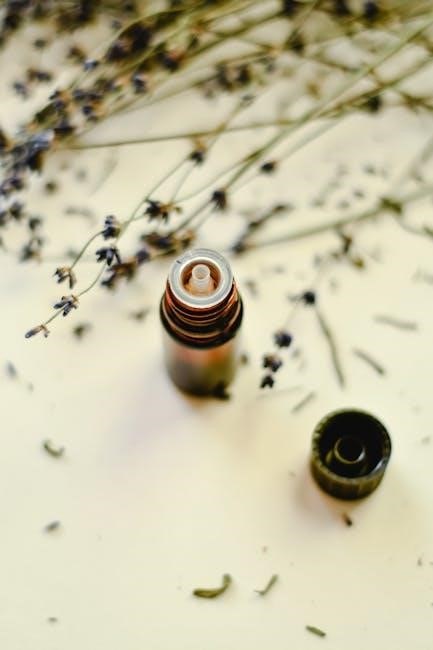
Methods of Using Essential Oils
Essential oils can be used through diffusion‚ topical application‚ or internal consumption; Diffusion enhances home atmosphere‚ while topical application requires dilution with carrier oils for safe use.
Diffusion: Enhancing Home Atmosphere
Diffusion is a popular method for enjoying essential oils‚ enhancing the home atmosphere with therapeutic benefits. Using a diffuser disperses oil particles into the air‚ promoting relaxation‚ improving mood‚ and purifying the environment. Popular oils like lavender and tea tree are often used for their calming and cleansing properties. Diffusion allows continuous aroma release‚ creating a balanced and refreshing space. It’s ideal for stress relief‚ sleep improvement‚ and boosting overall well-being without direct skin contact. Always follow guidelines for safe and effective diffusion practices.
Topical Application: Safety and Dilution
Topical application involves applying essential oils directly to the skin‚ but safety and proper dilution are crucial. Essential oils are highly concentrated‚ so mixing with carrier oils like jojoba or coconut oil is essential to avoid irritation. Typically‚ 1-3% dilution is recommended for adults‚ while children and sensitive individuals may require lower concentrations. Always perform a patch test and consult guidelines to ensure safe usage. Proper dilution enhances absorption and minimizes risks‚ making topical application effective for skin health and therapeutic benefits.
Internal Use: Precautions and Guidelines
Internal use of essential oils requires extreme caution due to their potency. Always consult healthcare professionals before ingestion‚ as improper use can lead to adverse effects. Quality matters; only pure‚ food-grade oils are safe for internal consumption. Start with minimal amounts‚ typically 1-2 drops in water or capsules‚ and monitor reactions. Certain oils‚ like peppermint and frankincense‚ can aid digestion or reduce inflammation when used correctly. Adhere to guidelines to ensure safety and effectiveness‚ as misuse can pose serious health risks.
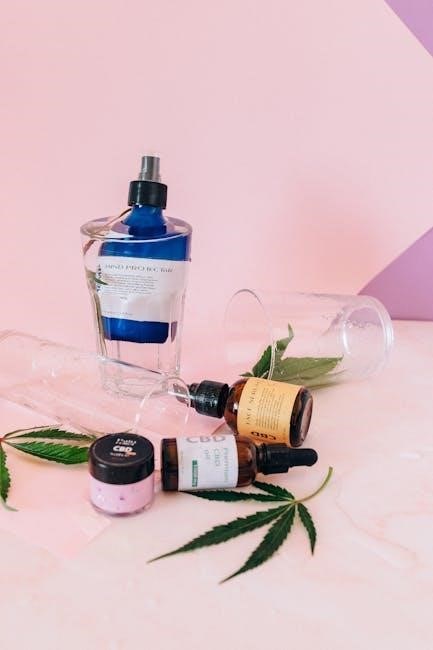
Safety Guidelines
Essential oils require careful handling to ensure safe use. Always dilute properly‚ perform allergy tests‚ and consult professionals‚ especially during pregnancy‚ to avoid adverse reactions and enhance benefits.
Proper Dilution Ratios
Proper dilution is crucial for safe essential oil use. Typically‚ mix 1-3% essential oil with a carrier oil‚ such as coconut or jojoba‚ for topical application. For children or sensitive skin‚ start with 0.5-1%. Always dilute before applying to avoid irritation. Refer to guidelines for specific oils‚ as some may require lower concentrations. Proper dilution enhances safety and effectiveness‚ ensuring a pleasant experience without adverse reactions.
Allergy Testing and Sensitivity
Allergy testing is essential to avoid adverse reactions. Always perform a patch test by applying a small‚ diluted amount of essential oil to the skin and wait 24-48 hours. If irritation occurs‚ discontinue use. Sensitivity varies‚ so start with minimal amounts and gradually increase as needed. Certain oils‚ like cinnamon or peppermint‚ are more potent and may cause reactions. Consulting a healthcare professional is advised for severe allergies or sensitive skin to ensure safe usage and effectiveness.
Essential Oils During Pregnancy
Using essential oils during pregnancy requires caution to ensure safety for both mother and baby. Always consult a healthcare provider before use‚ as some oils may stimulate the uterus or cause complications. Oils like lavender and chamomile are generally considered calming and safe in moderation. Avoid potent oils such as clary sage‚ rosemary‚ and cinnamon‚ which can pose risks. Proper dilution and minimal usage are crucial to prevent adverse effects. Self-care practices with essential oils should prioritize gentle and well-researched options to support relaxation and well-being during this sensitive time.
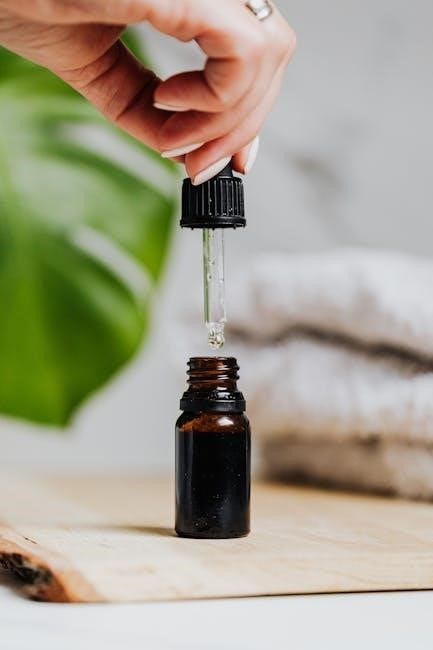
Blending Essential Oils
Blending essential oils combines their unique properties to create harmonious scents and enhance benefits. Start with 3-4 oils‚ balancing top‚ middle‚ and base notes for desired effects.
Basic Principles of Oil Blending
Mastering essential oil blending involves understanding the art of combining oils to achieve desired therapeutic and aromatic effects. Begin by selecting a dominant oil‚ then add complementary oils to enhance its properties. Always use high-quality‚ pure essential oils to ensure potency. Start with small batches and test the scent and effectiveness. Keep blends simple‚ using no more than 3-4 oils‚ and adjust proportions based on individual preferences and needs. This approach ensures balanced and effective blends for various uses.
Popular Essential Oil Blends
Discover popular essential oil blends that cater to various needs. The “Relaxation” blend combines lavender‚ chamomile‚ and bergamot for calming effects. “Energy Boost” features peppermint‚ lemon‚ and eucalyptus to invigorate. “Immunity Support” includes frankincense‚ tea tree‚ and oregano for wellness. “Skin Health” blends geranium‚ rosemary‚ and frankincense to promote glowing skin. These blends are widely used for their therapeutic benefits and aromatic appeal‚ offering natural solutions for everyday life.
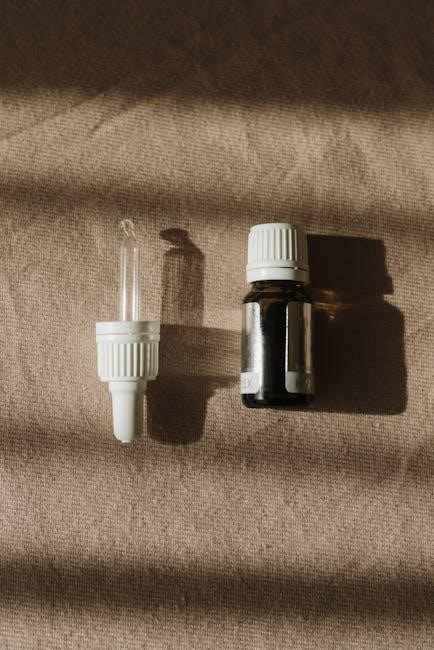
Recommended Resources
Explore essential oil books like The Complete Essential Oils Sourcebook and online guides offering comprehensive charts‚ safety tips‚ and practical blending advice for enhanced wellness and aromatherapy.
Books on Essential Oils and Aromatherapy
Discover comprehensive guides like The Complete Essential Oils Sourcebook by Julia Lawless‚ offering practical approaches to health and wellness. Essential Oils for Beginners provides a detailed introduction‚ while The Essential Oils Guide Book covers safety‚ blending‚ and therapeutic benefits. These books are invaluable resources for understanding the world of aromatherapy‚ ensuring safe and effective use of essential oils for relaxation‚ skin care‚ and overall well-being. They also include trend forecasts and business tips for wellness brands‚ making them versatile for both personal and professional use.
Online Guides and Comprehensive Charts
Explore essential oil resources like NOW Solutions’ Essential Oil Info Chart for quick snapshots of popular oils and blends. AromaWeb’s extensive guide offers detailed profiles‚ safety tips‚ and usage methods. Online charts compare therapeutic benefits‚ applications‚ and precautions‚ while guides like The Ultimate Essential Oils Guide cover trends‚ sustainability‚ and eco-friendly cleaning. These resources help users enhance wellness routines‚ ensuring safe and effective essential oil practices for relaxation‚ skin health‚ and holistic well-being. They’re perfect for both beginners and experienced enthusiasts seeking reliable information.